So you’ve decided to start or improve a B2B newsletter. Congratulations! You’re undertaking an endeavor with serious benefits to your business–that is, if done the right way.
There are too many lackluster B2B newsletters out there, but you won’t be one of them if you follow this guide.
I’ll go into the differences between B2C and B2B newsletters that you should know about and how to create a newsletter that people look forward to opening. Without further ado, let’s jump in.
What is a B2B newsletter? Is it the same thing as a B2B email?
A B2B newsletter is quite different from a B2B email marketing campaign. Its purpose is to nurture your prospects, not to increase sales (at least not right away).
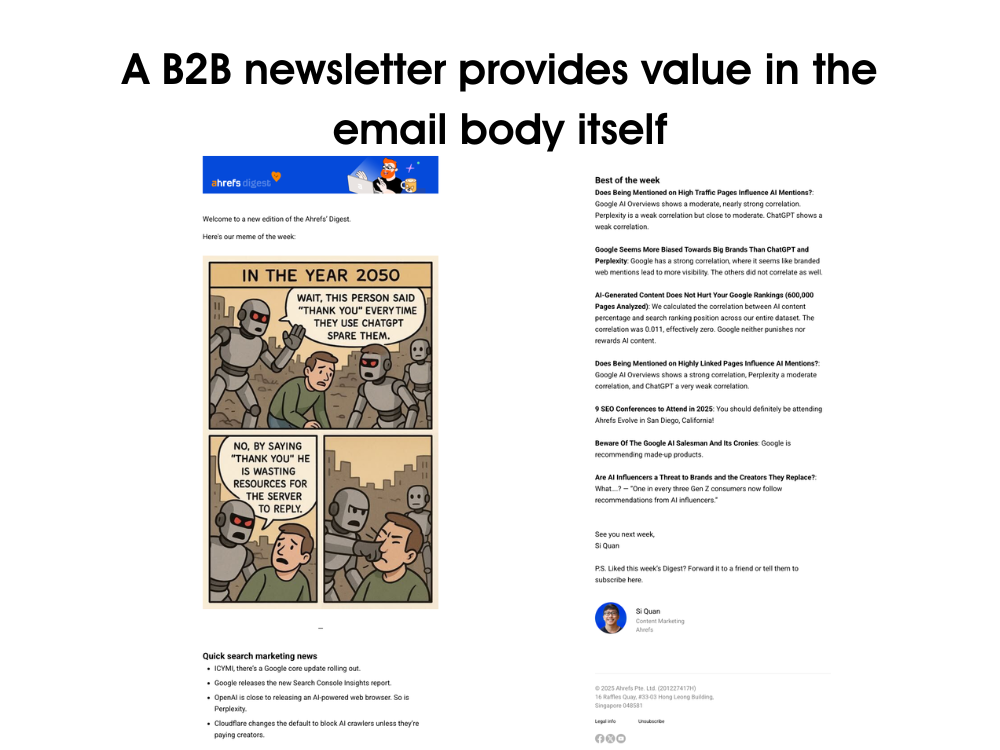
Newsletters are more like content marketing–they give value to a reader in the email body itself, without the reader having to click through a CTA. In contrast, traditional email marketing emphasizes conversions.
How is a B2B newsletter different from a B2C newsletter?
A B2B newsletter and a B2C newsletter have marked differences in their audiences.
A B2B customer's journey differs from that of a B2C customer. The content is different. The tone is different.
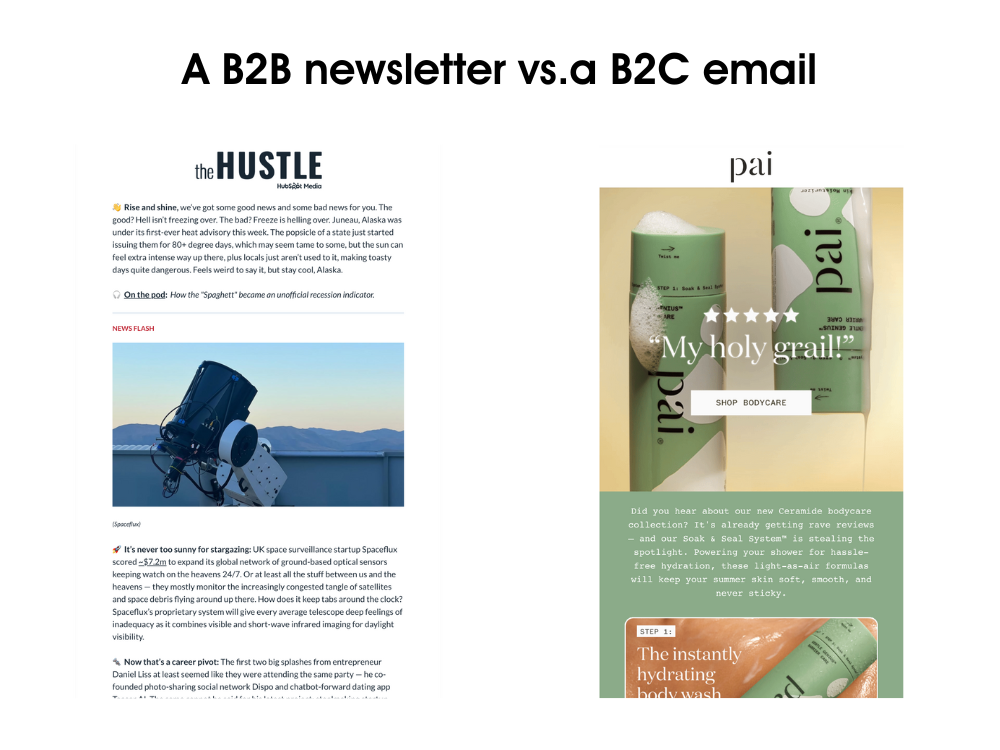
B2B customers often take longer to convert because you need to educate them about your product. Your product is more complex, and a discount isn’t as effective as it is for DTC and ecommerce products.
A B2B audience is, in a way, harder to impress. They are more discerning and are looking for value, above all else.
How to start a B2B newsletter that actually gets read
A few points to nail if you want a successful B2B newsletter that gets opened:
Know your audience well
Audience research is the foundation for a great B2B newsletter. Know your target audience and what they want to learn from you. Remember, the newsletter is about them, not you.
First, you have to define your audience (marketers, managers, C-suite, operations officers, etc.). Then, you have to tailor your content to problems they’re trying to solve, knowledge they should know, and goals they want to achieve.
Keep it brief
People, especially decision-makers, have short attention spans and limited time. Make your newsletter as short as you can get away with and no longer than that.
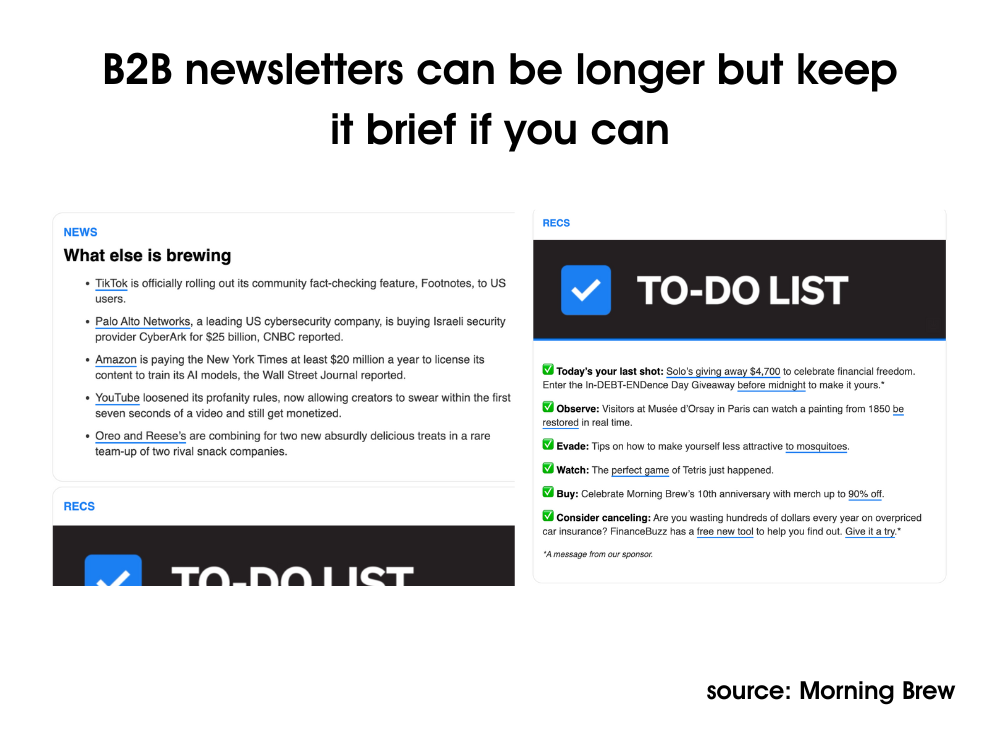
However, remember that B2B newsletters are longer than B2C, since it aims to nurture leads. You can add detailed information that you wouldn’t normally get away with in B2C.
If you need a deep-dive into a topic, consider cutting the content up into a series of emails.
Take an interesting angle
The best newsletters are usually the ones with a personal angle, a unique voice, and spicy takes. Just because you’re in B2B doesn’t mean you have to be bland and boring.
Know your target audience and what they want to learn from you. Remember, the newsletter is about them, not you.
To avoid this trap, add personality by infusing your newsletters with useful tips, humor, commentary, and context while still being true to your brand.
Don’t be like the hundreds of dull newsletters out there. Find your voice and develop it.
Make sure your emails are actually delivered
Email deliverability is perhaps the boring part of B2B newsletter creation, but it’s arguably the most important because if your newsletter doesn’t land where it’s supposed to (your subscribers’ inboxes), everything else is moot.
How do you ensure high deliverability? First, don’t be spammy. If your newsletter sounds or looks like spam, then it is spam and will be flagged as such.
Second, make sure you’re compliant with CAN-SPAM and GDPR, the two major laws that govern most emails.
CAN-SPAM is for US email providers while GDPR is for the EU.
To comply with these, do the following:
- Make your unsubscribe link visible in the email. No dirty tricks like camouflaging the unsubscribe button.
- Add your company’s mailing address to the email footer.
- This might sound basic: only send emails to people who have willingly signed up for your newsletter.
These tips are just scratching the surface. I encourage you to read up on these laws further.
Have a steady source of topics to talk about
I’ve covered the fundamentals. Now, we’ll go into the nitty-gritty: what do you talk about in your emails?
You have a lot of choices, especially if you already have other content in place. You can repurpose your existing content, such as blog posts, webinars, and case studies.
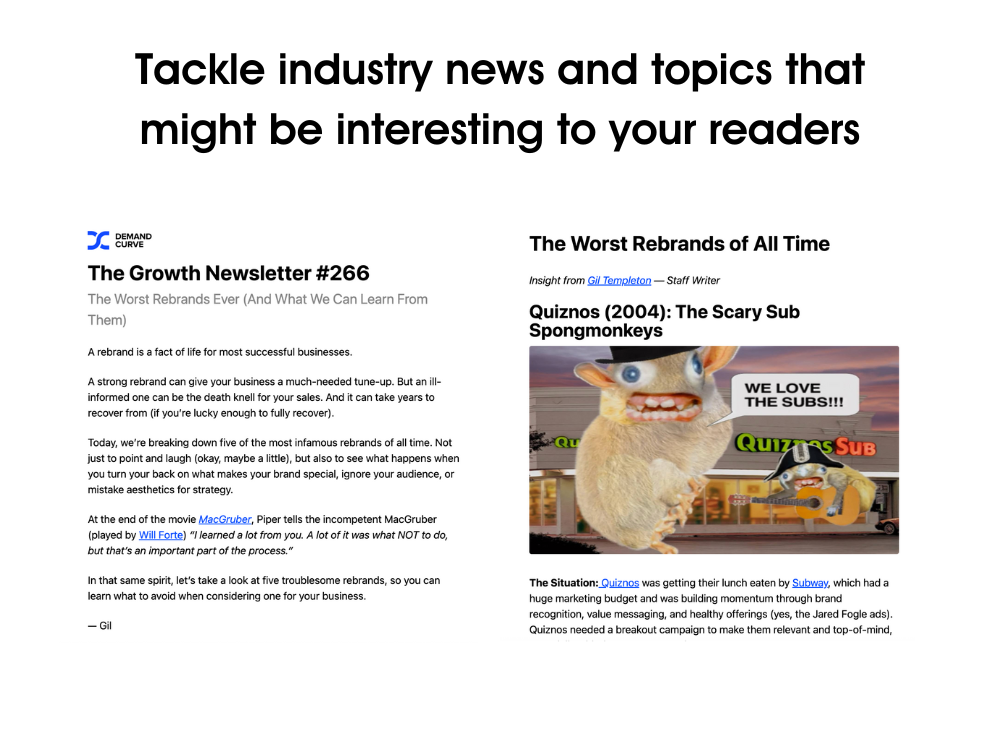
You can even do roundups of your most recent blog posts and videos or tackle industry news and trends that might be interesting to your readers.
Of course, you can still insert newsletters about your new products, company milestones, and customer feedback, but remember to do this sparingly.
Aside from that, you can try:
- White papers
- Invitations to webinars
- Behind-the-scenes content of your company
- FAQs
- Polls
- Customer wins
- Your personal takes
- Tips and tricks
If you want to know what content will reel in your target audience, look to your competitors or aspirational brands for inspiration.
Panoramata has a massive newsletter search engine where you can find newsletters from any industry or brand you can think of.
Write a punchy subject line and get them hooked
Recipients will overlook your carefully planned newsletter if you don’t write a good subject line to go along with it.
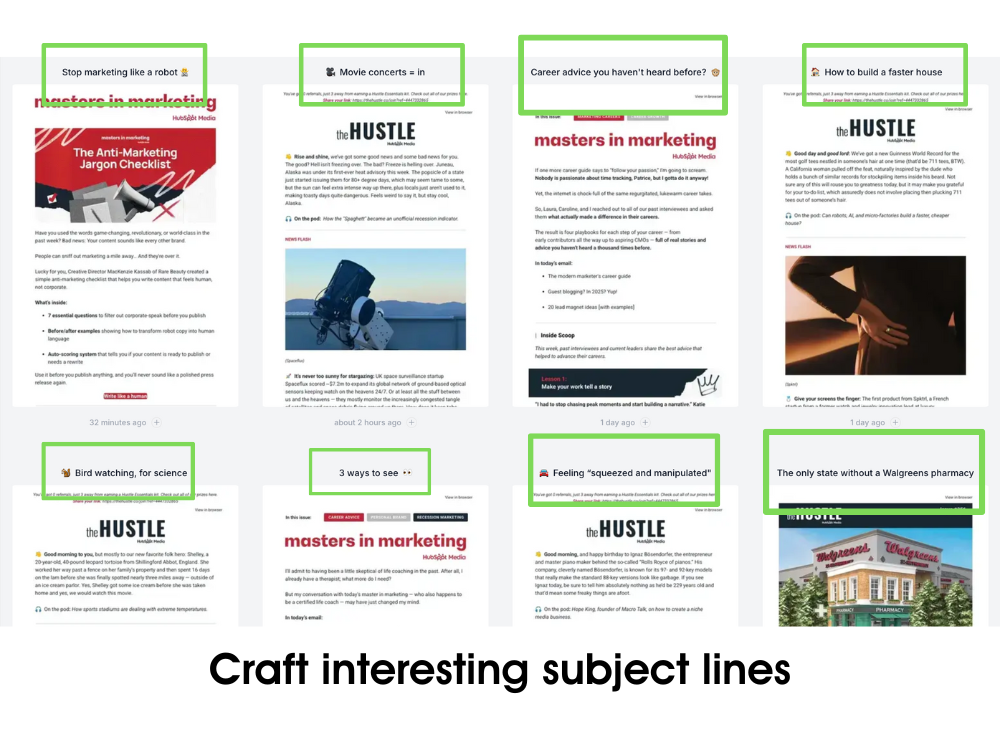
Personalization goes a long way in email subject lines. Add the recipient’s name. Segment your subscribers so you send emails that are relevant to them. It also helps to A/B test your subject lines to know what works.
Don’t be afraid of using emojis in your B2B newsletter. They easily make you stand out in an inbox. You can also pose a question that will leave them hanging, enough to make them want to click on the email.
Whatever you do, avoid clickbait or misleading subject lines. It breaches trust and can lead to unsubscribes.
Don’t forget about design
Design isn’t the most important thing in a B2B newsletter, but it still is important. When we talk about design, it’s not just about the aesthetics of your email.
While yes, you do have to fill up the space with great visuals, images, GIFs and what have you, you also need to think about the responsiveness of the email, how it works on both mobile and desktop, and its usability on different platforms.
In conclusion, make sure your newsletter looks good and works well across different devices.
Learn more B2B newsletter marketing best practices
That ends this guide on B2B newsletter creation. We hope you liked these tips and takeaways.
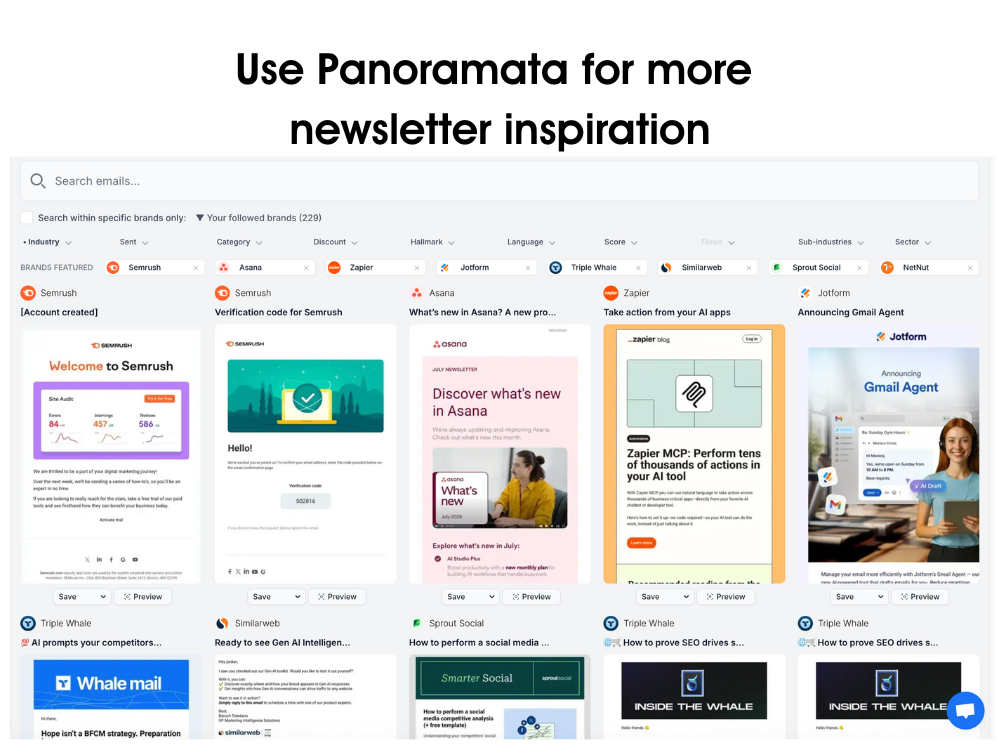
If you want even more newsletter inspiration and best practices, feel free to check out Panoramata.
You can find emails sent by brands of all sorts which you can use as fuel for your campaigns. Sign up for free today.
Want more ideas and inspiration? Check out our email swipe file with over 100 newsletter ideas you can use for your next campaign.
FAQs
What is the primary purpose of a B2B newsletter?
A B2B newsletter's main purpose is to nurture prospects and provide value, rather than directly driving sales.
How does a B2B newsletter differ from a B2C newsletter?
B2B newsletters cater to a more discerning audience with a longer customer journey, requiring more educational and value-driven content compared to B2C newsletters.
What are some important legal considerations for B2B newsletter creators?
It's important to comply with email regulations such as CAN-SPAM (for the US) and GDPR (for the EU) by ensuring a visible unsubscribe link, including your mailing address, and only sending to opted-in subscribers.












